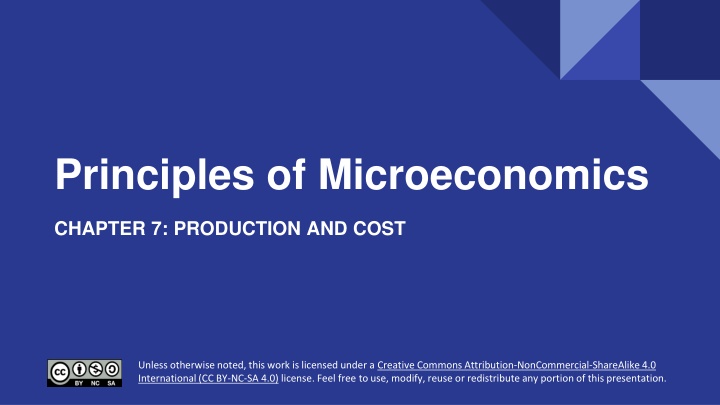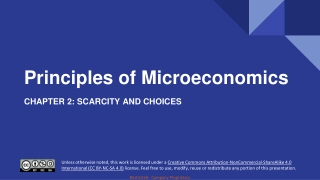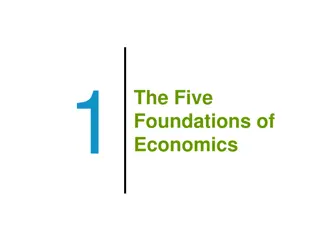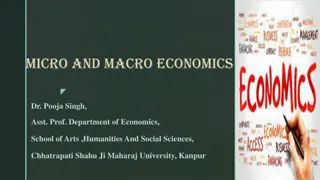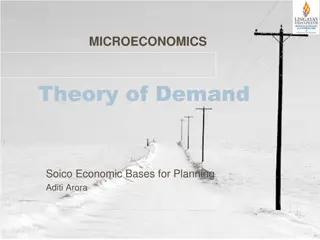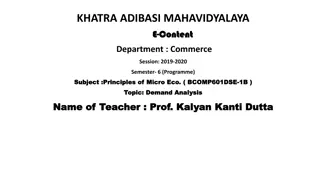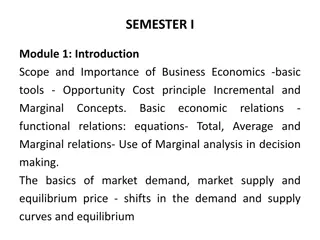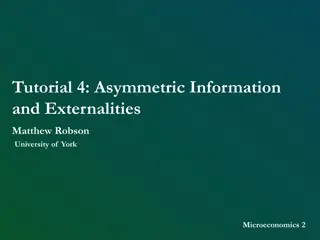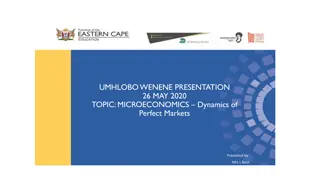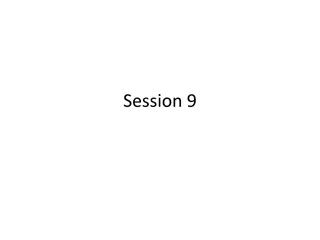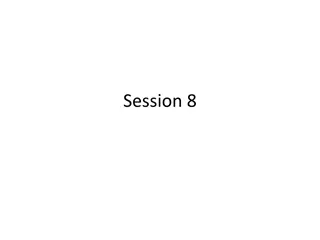Principles of Microeconomics
This chapter delves into the concepts of production and cost in microeconomics, covering total revenue, explicit and implicit costs, accounting profit, economic profit, and more. Gain insights into technology examples, short-run versus long-run, marginal and average products of labor, costs graphs, and firms' long-run decisions.
Download Presentation

Please find below an Image/Link to download the presentation.
The content on the website is provided AS IS for your information and personal use only. It may not be sold, licensed, or shared on other websites without obtaining consent from the author.If you encounter any issues during the download, it is possible that the publisher has removed the file from their server.
You are allowed to download the files provided on this website for personal or commercial use, subject to the condition that they are used lawfully. All files are the property of their respective owners.
The content on the website is provided AS IS for your information and personal use only. It may not be sold, licensed, or shared on other websites without obtaining consent from the author.
E N D
Presentation Transcript
Principles of Microeconomics CHAPTER 7: PRODUCTION AND COST Unless otherwise noted, this work is licensed under a Creative Commons Attribution-NonCommercial-ShareAlike 4.0 International (CC BY-NC-SA 4.0) license. Feel free to use, modify, reuse or redistribute any portion of this presentation.
Learning Outcomes At the end of this chapter, you will be able to: Describe technology and examples Explain short-run and long-run Describe marginal and average products of labor Elaborate marginal and average costs Recognize average costs and marginal costs graphs Identify firms long-run decisions
7.1 Total Revenue Profit = Total Revenue Total Cost Total revenue is the income the firm generates from selling its products. We calculate it by multiplying the price of the product times the quantity of output sold Total Revenue = Price Quantity
7.1 Explicit and Implicit Costs Explicit Costs: Are out-of-pocket costs, that is, actual payments. The wage and rent that a firm pays for office space are explicit costs. Implicit Costs: Are more subtle but just as important. They represent the opportunity cost of using resources that the firm already owns. Often for small businesses, they are resources that the owners contribute.
7.1 Accounting Profit and Economic Profit Accounting Profit: Is a cash concept. It means total revenue minus explicit costs the difference between dollars brought in and dollars paid out. Economic Profit: Is total revenue minus total cost, including both explicit and implicit costs. The difference is important because even though a business pays income taxes based on its accounting profit, whether or not it is economically successful depends on its economic profit.
7.1 Economic Profit Economic Profit: Current opportunity is better than old opportunity. E.g.: I make $100,000 but used to make $80,000 Economic Loss: Current opportunity is worse than old opportunity. E.g.: I make $100,000 but used to make $200,000 Economic Breakeven: Current opportunity is equally as good as old opportunity. E.g.: I make $100,000 and used to make $100,000
7.1 Calculating Implicit and Explicit Costs Fred currently works for a corporate law firm. He is considering opening his own legal practice, where he expects to earn $200,000 per year once he establishes himself. To run his own firm, he would need an office and a law clerk. He has found the perfect office, which rents for $50,000 per year. He could hire a law clerk for $35,000 per year. If these figures are accurate, would Fred s legal practice be profitable?
7.1 Calculating Implicit and Explicit Costs Step 1 Step 1. First you must calculate the costs. You can take what you know about explicit costs and total them: Office rental + Law clerk s salary = Total explicit costs: $50,000 + $35,000 = $85,000 Total explicit costs: $85,000
7.1 Calculating Implicit and Explicit Costs Step 2 Step 2. Subtracting the explicit costs from the revenue gives you the accounting profit. Accounting profit: Revenue minus explicit costs = $200,000 $85,000 = $115,000 However, these calculations consider only the explicit costs. To open his own practice, Fred would have to quit his current job, where he is earning an annual salary of $125,000. This would be an implicit cost of opening his own firm.
7.1 Calculating Implicit and Explicit Costs Step 3 Step 3. You need to subtract both the explicit and implicit costs to determine the true economic profit: Economic profit = total revenues explicit costs implicit costs = $200,000 $85,000 $125,000 = $10,000 per year Fred would be losing $10,000 per year. That does not mean he would not want to open his own business, but it does mean he would be earning $10,000 less than if he worked for the corporate firm. Implicit costs can include other things as well. Maybe Fred values his leisure time and starting his own firm would require him to put in more hours than at the corporate firm. In this case, the lost leisure would also be an implicit cost that would subtract from economic profits.
7.2 Production Production is the process (or processes) a firm uses to transform inputs (e.g., labour, capital, raw materials) into outputs, i.e., the goods or services the firm wishes to sell. We can summarize the ideas so far in terms of a production function, a mathematical expression or equation that explains the engineering relationship between inputs and outputs.
7.2 Assuming labour (L) and capital (K) Assuming labour (L) and capital (K) are the two main inputs used in the production, we can write the production function as: Q = f [L, K]
7.2 Fixed Inputs and Variable Inputs Fixed inputs: Are those that can t easily be increased or decreased in a short period of time. In the pizza example, the building is a fixed input. Once the entrepreneur signs the lease, he or she is stuck in the building until the lease expires. Fixed inputs define the firm s maximum output capacity. Variable inputs: Are those that can easily be increased or decreased in a short period of time. The pizzaiolo can order more ingredients with a phone call, so ingredients would be variable inputs. The owner could hire a new person to work the counter pretty quickly as well. So labour is a variable input.
7.2 Short and Long-Run Production The Short-Run: Is the period of time during which at least one or more factors of production are fixed. During the period of the pizza restaurant lease, the pizza restaurant is operating in the short run, because it is limited to using the current building (an example of capital) the owner can t choose a larger or smaller building. Plant size or capital is a fixed factor of production in the short run. The Long Run: Is the period of time during which all factors are variable. Once the lease expires for the pizza restaurant, the shop owner can move to a larger or smaller place.
7.2 Total product and Marginal Product Output (Q) as Total Product (TP): TP is the amount of output produced with a given number of labors and a fixed amount of capital. In this example, one barber can give 8 haircuts in a day. Two barbers can produce 22 haircuts in a day and so on. Marginal Product: Marginal product is the additional output of one more worker. Mathematically, Marginal Product is the change in total product divided by the change in labour: MP= TP L
7.2 The Average Product The Average Product of labour is the total product divided by the quantity of labour. AP=TP L. As the marginal product rises, so does the average product, and as the marginal product starts to diminish, the average product starts falling too. Generally, as long as: MP > AP, AP rises MP < AP, AP falls MP = AP, AP is maximum (maximum productivity of the business)
7.2 Relationship Between MP and AP This relationship between MP and AP is mathematically true. Suppose, 5 friends plan to go for dinner, each carrying $20. In that case, the average amount that each friend is carrying is $20*5/5 = $20. Now suppose a sixth friend joins in for dinner who is carrying $25. Then the average rises to approximately $21. So the amount carried by the sixth friend is like the marginal product in our example, which is greater than the average product of $20, and that pulls up the average to about $21. Conversely, if the sixth friend carries $16, then the average changes to $19. Therefore, we find when the marginal ($16) falls below the average ($20), that pulls the average product down ($19). And when the sixth friend carries the same amount of $20 as the five others, the marginal and average both remain the same at $20.
7.3 Costs of Production Total Costs (TC) of production in the short run, a useful starting point is to divide total costs into two categories: 1. Fixed Cost of production is the cost that does not change as output changes. 2. Variable Cost is the cost that changes as output changes.
7.3 Total Fixed Costs Example A salon manager s total fixed costs are his expenditures that do not change regardless of the number of haircuts offered. Whether he gets a lot or a few customers, his fixed costs are the same. When the manager signs the lease to rent the salon space, the rent costs him $60 a day, regardless of the number of haircuts given. This lease has now become a sunk cost since there is nothing the manager can do to get his money back.
7.3 Total Variable Costs Example The salon manager s total variable costs are incurred in the act of producing the more he produces, the greater the variable cost. After signing the lease for the salon and purchasing the required hair cutting equipment, the manager now has to find workers to offer haircuts. The more haircuts he wants to offer every hour, the more workers he needs to hire. For this reason, his variable costs are increasing as his production (or service) increases. Assuming the wage cost for each labour is $80/day.
7.3 Fig 7.5 Explained The table above (Fig 7.5) shows us the fixed cost and the variable cost of production for haircuts, as the manager keeps hiring more barbers to offer more haircut services each day. Note when the total output is zero the firm still incurs a fixed cost of $60 as rental cost per day. The fifth column shows the total cost of production which is the sum of TFC and TVC. TC = TFC + TVC
7.3 Marginal Cost and Average Total Cost Marginal Cost (MC): Is the change in total cost divided by the change in total output or TP. MC = TC TP Average Total Cost (ATC): Is the total cost divided by total output. TC = TFC + TVC TC TP = TFC TP + TVC TP (dividing all three expressions by TP) ATC = AFC + AVC where, AFC = TFC TP and AVC = TVC TP
7.3 Fig 7.8 Explained The marginal cost curve intersects the average cost curve exactly at the bottom of the average cost curve. This is where the average cost reaches its minimum. The reason why the intersection occurs at this point is built into the economic meaning of marginal and average costs. If the marginal cost of production is below the average cost of producing previous units, as it is for the points to the left of where MC crosses AVC, then producing one additional unit will reduce average costs overall and the AVC curve will be downward-sloping in this zone.
7.4 Relationship between Production and Costs Part 1 Panel A in Fig 7.9 shows the average and marginal product curves. Notice when marginal product lies above average product, average product rises and when marginal product lies below average product, the average product falls. The point where the two are equal is the point of maximum average productivity Fig 7.9(A)
7.4 Relationship between Production and Costs Part 2 When AP starts falling, average costs start increasing. Due to the law of diminishing returns resulting from fixed capital in the short run, adding more labour lowers each worker s marginal returns. Fig 7.9(B)
7.5 Long Run Costs: The Advantage of Flexibility Short-run average costs are constrained by the presence of a fixed input. So in the long run we can always do at least as well as, and often better than, in the short run with respect to cost. We can see this is true by comparing the long-run and short-run average cost curves. Flexibility Geralt Pixabay Flexibility by Geralt, licensed by Pixabay
7.5 Shapes of Long-Run Average Cost Curves The long-Run Average Cost (LRAC) Curve: Is based on a group of short- run average cost (SRAC) curves, each of which represents one specific level of fixed costs. More precisely, the long-run average cost curve will be the least expensive average cost curve for any level of output. While in the short run firms are limited to operating on a single average cost curve (corresponding to the level of fixed costs they have chosen), in the long run when all costs are variable, they can choose to operate on any average cost curve.
7.5 Long-Run Average Cost Example Fig 7.10
7.5 Fig 7.10 Explained Shows how we build the long-run average cost curve from a group of short- run average cost curves. Five short-run-average cost curves appear on the diagram. Each SRAC curve represents a different level of fixed costs. Imagine SRAC1 as a small factory, SRAC2 as a medium factory, SRAC3 as a large factory, and SRAC4 and SRAC5 as very large and ultra-large. Although this diagram shows only five SRAC curves, presumably there are an infinite number of other SRAC curves between the ones that we show.
7.5 Economies of Scale Economies of Scale occur when the average cost of production falls as output increases. Economies of Scale refer to the situation where, as the quantity of output goes up, the cost per unit goes down. This is the idea behind warehouse stores like Costco or Walmart. In everyday language: a larger factory can produce at a lower average cost than a smaller factory.
7.5 Diseconomies of scale Diseconomies of scale occur when the average cost of production rises as output increases. Constant returns to scale occur when the average cost of production does not change as output rises. In a typical long-run average cost curve, there are sections of both economies of scale and diseconomies of scale. Minimum efficient scale where the average cost is at its minimum. This is the point where economies of scale are used up and no longer benefit the firm.
7.5 Constant Returns to Scale Fig 7.12 Fig 7.11
Key Terms Long-Run Average Cost (LRAC) Marginal Product Minimum Efficient Scale Production Production Function Short-Run Total Costs (TC) Total Fixed Costs Total Product (TP) Total Revenue Total Variable Costs Variable Inputs Accounting Profit Average Product Constant Returns to Scale Diseconomies of Scale Economic Profit Economies of Scale Explicit Costs Fixed Inputs Implicit Costs Short Run Long Run
